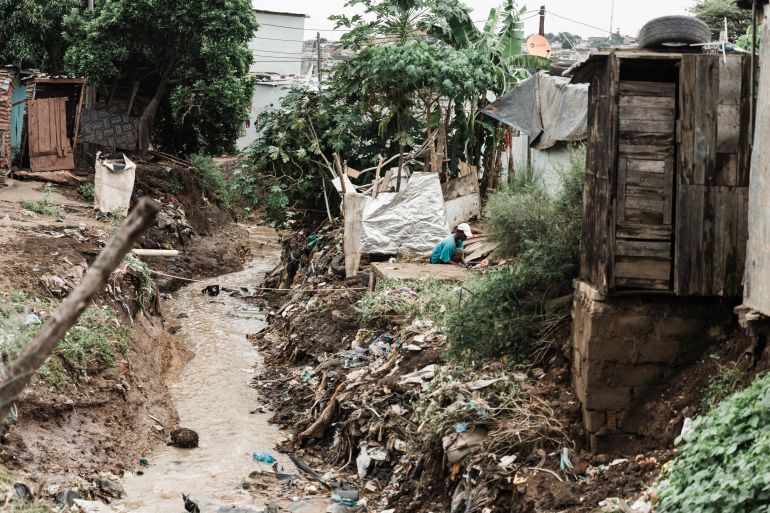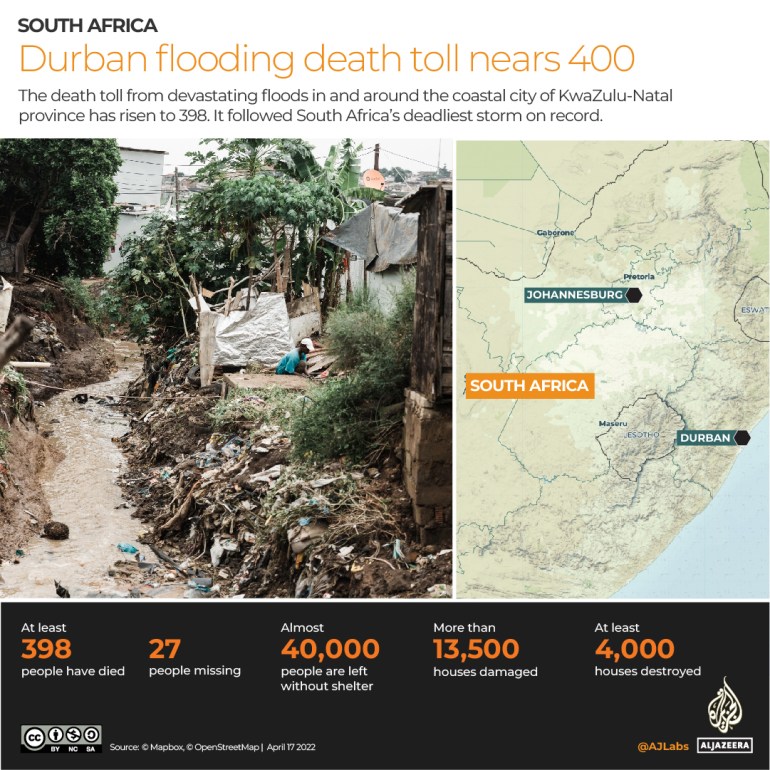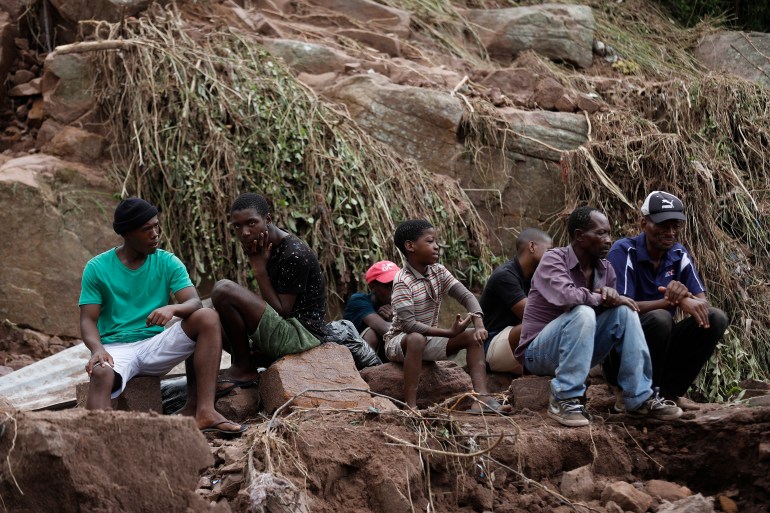Rain continues to hit South Africa’s flood-ravaged east
Hundreds of people killed and tens of thousands displaced by nearly a week of floods in KwaZulu-Natal province.

South Africa’s flood-ravaged east was hit by more rain after the deadliest storm to strike the country in living memory killed nearly 400 people and left tens of thousands homeless.
Floodwaters engulfed parts of the eastern coastal city of Durban this week, ripping apart roads, destroying hospitals, and sweeping away homes and those trapped inside.
Keep reading
list of 3 itemsSouth Africa’s poor struggle for land rights post-apartheid
South Africa most unequal country in the world: Report
Emergency services in the southeastern KwaZulu-Natal (KZN) province, where Durban is located, were on high alert as weather forecasters predicted more rain this weekend.

“The death toll has increased and currently stands at 398, with 27 people still missing,” a government official said on Saturday, announcing that 58 hospitals and clinics had been “severely affected”.
Recovery operations and humanitarian relief are under way in the city of 3.5 million people that would normally have been teeming with Easter holidaymakers this weekend.
“It’s already raining in some parts of KZN but it won’t be as hectic as it was in the past few days,” Puseletso Mofokeng, senior forecaster at the South Africa Weather Service, told the AFP news agency.
“But because of the soil being over-saturated with water, we can still get a lot of flooding,” he warned.
Between 25mm (one inch) and 45mm (1.75 inches) of rain was expected Saturday, compared with the more than 300mm (11.8 inches) that fell within a 24-hour period in some regions on Monday.
The latest rains, which have left at least 40,000 people without shelter, power or water this week, are expected to continue until early next week.
“We’ve got no water, no electricity, even our phones are dead. We’re stuck,” said Gloria Linda, as she sheltered under a large umbrella by a muddy road in her Kwandengezi township, about 30km (20 miles) inland from Durban.
Disaster management teams said they were on “high alert to swiftly respond to communities known to be at high risk, to avert or minimise the disaster impact“.
Shawn Herbst of the first responder company Netcare 911 said, “Sadly, there are still bodies being recovered from homesteads, especially from the rural areas.”
“There is still damage taking place, especially with the rain we are experiencing today.”

‘Another disaster’
The floods have damaged more than 13,500 houses and completely destroyed about 4,000.
Authorities have urged people in high-risk areas to move to community facilities such as halls and schools.
Clean water is scarce and authorities have promised to deploy water tankers.
In Umlazi, one of the country’s largest townships, south of Durban, flood victims huddled under blankets in a community hall, while others formed long queues for handouts of food and water donated by charities.
“What makes me angry is that this situation is always happening,” said Mlungeli Mkokelwa, a 53-year-old man who arrived at the settlement a decade ago to look for work that he never found.
“Our possessions keep getting destroyed by continuous floods that should be addressed by authorities. No one ever comes back with a plan to solve it.”
The government has announced one billion rand ($68m) in emergency relief funding.
South African billionaire and Confederation of African Football (CAF) chief Patrice Motsepe donated what he called a “humble contribution” of 30 million rand ($2m).
“Our people are suffering. We really want the 30 million to be spent as matter of urgency,” said Motsepe announcing the donation before the Zulu King, Misuzulu Zulu, at a hall sheltering displaced people.
Finding survivors, recovering bodies
Six days after the floods first struck, hope of finding survivors is now fading and Durban Emergency Medical Services spokesman Robert McKenzie said the response was focusing on recovery and humanitarian relief.
“There has been a shift in response to the emergency as we have moved from the emergency phase to the recovery phase of the disaster,” he said.
Survivors are still desperately looking for missing relatives.
“We are getting calls constantly on a daily basis. Yesterday there were 35 calls attended to, and there were six bodies recovered,” said Travis Trower, director for the volunteer-run organisation Rescue South Africa.
South Africa, the continent’s most industrialised country, is also struggling to recover from the two-year-old COVID pandemic and deadly riots last year that killed more than 350 people, mostly in the now flood-struck southeastern region.
“Just as we thought it was safe to get out of [the COVID] disaster, we have another disaster, a natural disaster descending on our country,” President Cyril Ramaphosa said in a Good Friday speech.
The floods are “a catastrophe of enormous proportions … not seen before in our country”.